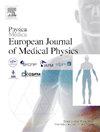靶向α疗法使用2111at:剂量和DNA损伤的Geant4模拟。
IF 3.3
3区 医学
Q1 RADIOLOGY, NUCLEAR MEDICINE & MEDICAL IMAGING
Physica Medica-European Journal of Medical Physics
Pub Date : 2025-01-01
DOI:10.1016/j.ejmp.2024.104860
引用次数: 0
摘要
靶向α治疗因其高线性能量转移(LET)和低范围而显示出巨大的癌症治疗潜力。2111at目前用于临床试验。靶向α疗法(TAT)是一种有效的辅助治疗癌症或治疗微转移和弥漫性癌症。更深入地了解诱导的初始损伤对加强治疗计划至关重要。方法:本研究采用基于Geant4(-DNA)的模拟来计算静脉注射211At的TAT的吸收剂量谱和DNA损伤潜力。它假设放射性核素在血管壁上衰变,并计算周围组织的DNA损伤。结果:计算的剂量学量表明,这种处理的效果主要是由于发射的α粒子,并且定位在距离血管80μm的区域。处理的RBE在2.5-4范围内,并作为双链断裂次数的函数计算。结论:2111at靶向治疗在α粒子发射范围内是有效的。由于其在短时间内诱导复杂DNA损伤的能力,它非常有希望用于小肿瘤细胞或微转移的局部治疗。本文章由计算机程序翻译,如有差异,请以英文原文为准。
Targeted alpha therapies using 211At: A Geant4 simulation of dose and DNA damage
Introduction
:Targeted alpha therapies show great potential for cancer treatment due to their high linear energy transfer (LET) and low range. 211At is currently employed in clinical trials. Targeted alpha therapies (TAT) are effective as an adjuvant treatment for cancer or to treat micrometastases and diffuse cancers. A deeper understanding of the induced initial damage is crucial to enhance treatment planning.
Methods:
This study shows Geant4(-DNA)-based simulations to calculate absorbed dose profiles and DNA damaging potential in intravenously administered TAT with 211At. It assumes radionuclide decay on the blood vessel wall, and calculates the DNA damage in the surrounding tissue.
Results:
The calculated dosimetric quantities show that the effect of such treatment is mainly due to the emitted alpha particles, and is localised in a region of up to from the blood vessel. The RBE of the treatment is in the range , and is calculated as a function of the number of double-strand breaks.
Conclusions:
Targeted therapies with 211At are effective within the range of the emitted alpha particles. With its capacity to induce complex DNA damage in such a short range, it is very promising for localised treatment of small tumour cells or micrometastases.
求助全文
通过发布文献求助,成功后即可免费获取论文全文。
去求助
来源期刊
CiteScore
6.80
自引率
14.70%
发文量
493
审稿时长
78 days
期刊介绍:
Physica Medica, European Journal of Medical Physics, publishing with Elsevier from 2007, provides an international forum for research and reviews on the following main topics:
Medical Imaging
Radiation Therapy
Radiation Protection
Measuring Systems and Signal Processing
Education and training in Medical Physics
Professional issues in Medical Physics.

 求助内容:
求助内容: 应助结果提醒方式:
应助结果提醒方式:


